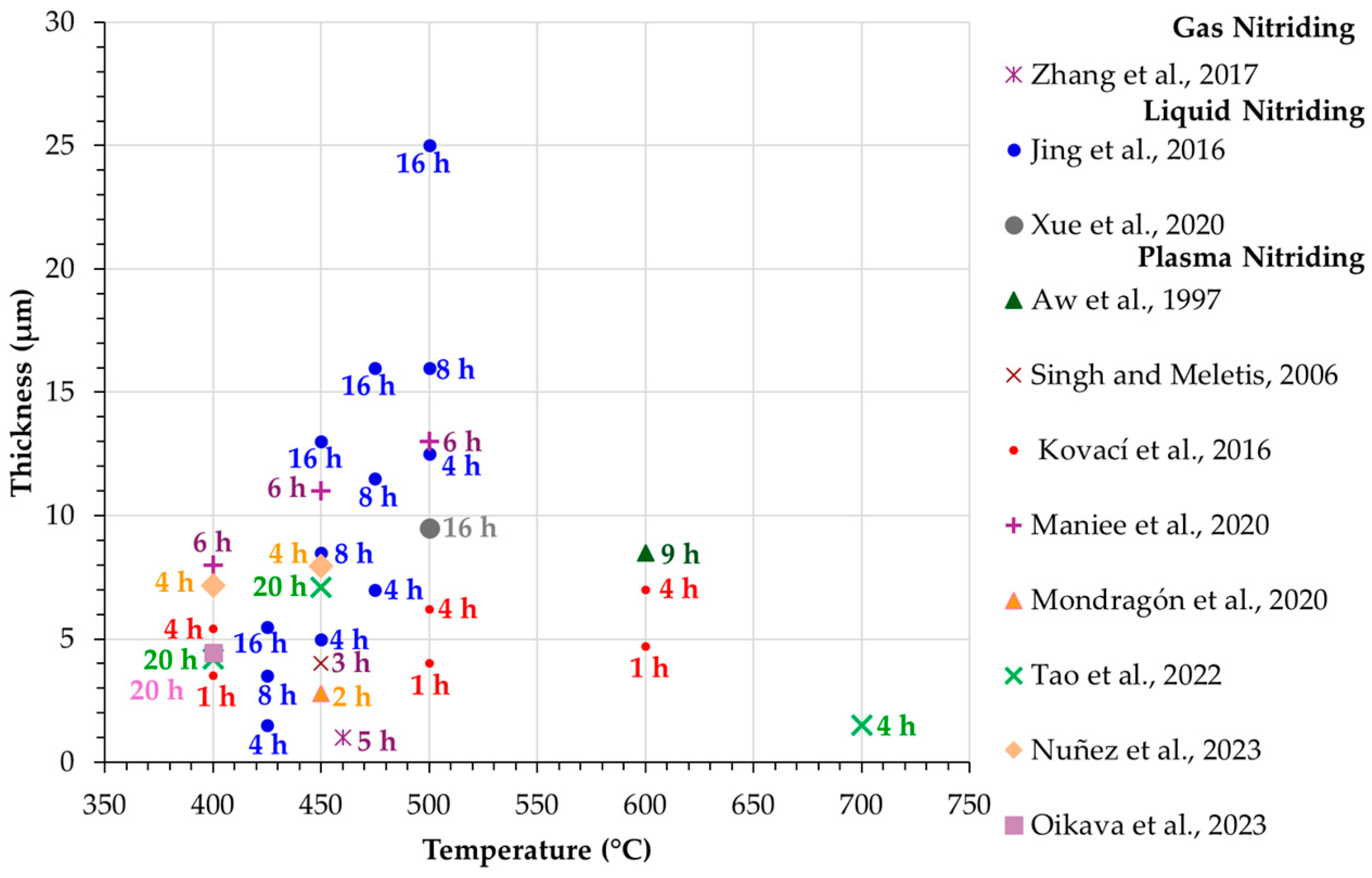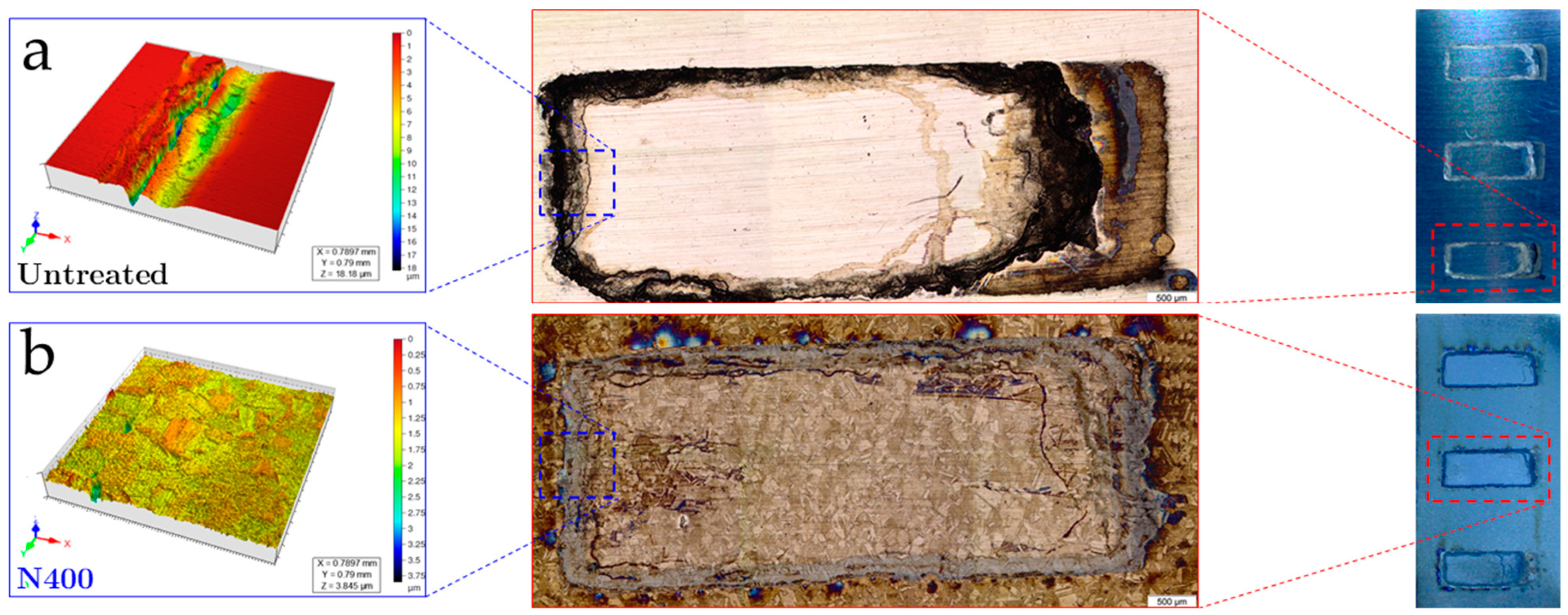Nitriding Treatments in Nickel–Chromium-Based Superalloy INCONEL 718: A Review
Abstract
:1. Background
2. Research Methodology
- Green: ‘Nitriding’, ‘Plasma Nitriding’, ‘INCONEL 718’, and ‘Corrosion’ as the main keywords with 14, 13, 12, and 11 occurrences, respectively. Those terms are associated with general aspects of nitriding, such as ‘surface treatment’, ‘scanning electron microscopy’, ‘treatment temperature’, and ‘hardness’.
- Red: ‘Nickel alloys’, ‘Wear’, and ‘Chromium nitrides’ as the main keywords with 11, 11, and 10 occurrences, respectively. Those keywords were linked to related terms such as ‘friction’, ‘tribology’, ‘surface roughness’, ‘nitrogen’, and ‘nitrided layer’.
3. Review of the Properties and Characteristics of Nitrided UNS N07718
3.1. Hardness and Nitrided Layer Thickness
3.2. Corrosion
3.3. Wear
4. Final Remarks
Author Contributions
Funding
Institutional Review Board Statement
Informed Consent Statement
Acknowledgments
Conflicts of Interest
References
- Klapper, H.S.; Zadorozne, N.S.; Rebak, R.B. Localized Corrosion Characteristics of Nickel Alloys: A Review. Acta Metall. Sin. 2017, 30, 296–305. [Google Scholar] [CrossRef]
- DuPont, J.N.; Lippold, J.C.; Kiser, S.D. Welding Metallurgy and Weldability of Nickel-Base Alloys; John Wiley & Sons, Inc.: Hoboken, NJ, USA, 2009. [Google Scholar] [CrossRef]
- Precision Castparts Corporation Special Metals-Handbooks, Guides, Brochures. Available online: https://www.specialmetals.com/documents/guides-and-handbooks (accessed on 22 July 2024).
- Houghton, A.; Lewis, R.; Olofsson, U.; Sundh, J. Characterising and Reducing Seizure Wear of Inconel and Incoloy Superalloys in a Sliding Contact. Wear 2011, 271, 1671–1680. [Google Scholar] [CrossRef]
- Oikava, Y.I.; Kurelo, B.C.E.S.; Pintaude, G.; Mazur, V.T.; Li, X.; Dong, H. The Effect of Counterbody Material on Tribological Behavior of Active Screen Plasma-Nitrided Inconel 718 Under Saline Solution. Tribol. Lett. 2023, 71, 116. [Google Scholar] [CrossRef]
- Nuñez de la Rosa, Y.; Palma Calabokis, O.; Ballesteros-Ballesteros, V.; Tafur, C.L.; Borges, P.C. Assessment of the Pitting, Crevice Corrosion, and Mechanical Properties of Low-Temperature Plasma-Nitrided Inconel Alloy 718. Metals 2023, 13, 1172. [Google Scholar] [CrossRef]
- Chollet, S.; Pichon, L.; Cormier, J.; Dubois, J.B.; Villechaise, P.; Drouet, M.; Declemy, A.; Templier, C. Plasma Assisted Nitriding of Ni-Based Superalloys with Various Microstructures. Surf. Coat. Technol. 2013, 235, 318–325. [Google Scholar] [CrossRef]
- Mondragón-Rodríguez, G.C.; Torres-Padilla, N.; Camacho, N.; Espinosa-Arbeláez, D.G.; de León-Nope, G.V.; González-Carmona, J.M.; Alvarado-Orozco, J.M. Surface Modification and Tribological Behavior of Plasma Nitrided Inconel 718 Manufactured via Direct Melting Laser Sintering Method. Surf. Coat. Technol. 2020, 387, 125526. [Google Scholar] [CrossRef]
- Tao, X.; Kavanagh, J.; Li, X.; Dong, H.; Matthews, A.; Leyland, A. An Investigation of Precipitation Strengthened Inconel 718 Superalloy after Triode Plasma Nitriding. Surf. Coat. Technol. 2022, 442, 128401. [Google Scholar] [CrossRef]
- Xue, L.; Wang, J.; Li, L.; Chen, G.; Sun, L.; Yu, S. Enhancement of Wear and Erosion-Corrosion Resistance of Inconel 718 Alloy by Liquid Nitriding. Mater. Res. Express 2020, 7, 096510. [Google Scholar] [CrossRef]
- Zhang, H.; Qin, H.; Ren, Z.; Zhao, J.; Hou, X.; Doll, G.L.; Dong, Y.; Ye, C. Low-Temperature Nitriding of Nanocrystalline Inconel 718 Alloy. Surf. Coat. Technol. 2017, 330, 10–16. [Google Scholar] [CrossRef]
- Maniee, A.; Mahboubi, F.; Soleimani, R. Improved Hardness, Wear and Corrosion Resistance of Inconel 718 Treated by Hot Wall Plasma Nitriding. Met. Mater. Int. 2020, 26, 1664–1670. [Google Scholar] [CrossRef]
- Jing, Y.; Jun, W.; Tan, G.; Ji, X.; Hongyuan, F. Phase Transformations during Low Temperature Nitrided Inconel 718 Superalloy. ISIJ Int. 2016, 56, 1076–1082. [Google Scholar] [CrossRef]
- Cardoso, R.P.; Mafra, M.; Brunatto, S.F. Low-Temperature Thermochemical Treatments of Stainless Steels–An Introduction. In An Introduction, Plasma Science and Technology-Progress in Physical States and Chemical Reactions; IntechOpen: London, UK, 2016; pp. 107–130. [Google Scholar]
- Van Eck, N.J.; Waltman, L. Software Survey: VOSviewer, a Computer Program for Bibliometric Mapping. Scientometrics 2010, 84, 523–538. [Google Scholar] [CrossRef] [PubMed]
- Van Eck, N.J.; Waltman, L. Visualizing Bibliometric Networks. In Measuring Scholarly Impact; Springer: Berlin/Heidelberg, Germany, 2014; pp. 285–320. [Google Scholar]
- Centre for Science and Technology Studies. VOSviewer; Centre for Science and Technology Studies: Leiden, The Netherlands, 2023. [Google Scholar]
- Singh, V.; Meletis, E.I. Synthesis, Characterization and Properties of Intensified Plasma-Assisted Nitrided Superalloy Inconel 718. Surf. Coat. Technol. 2006, 201, 1093–1101. [Google Scholar] [CrossRef]
- Li, X.; Luo, D.; Han, R.; Zhu, W. Effect of Nitriding Temperature on the Wear and Corrosion Behavior of the Inconel 718 Alloy. Jinshu Rechuli/Heat Treat. Met. 2017, 42, 170–175. [Google Scholar] [CrossRef]
- De Figueiredo Cavalcante, D.; Lage, M.A.; de Assis, K.S.; de Carvalho, M.G.M.; Alves, F.P.; Mattos, O.R. The Effect of Low Temperature Diffusional Heat Treatments on the Corrosion Resistance of Nickel Alloys. In Proceedings of the CORROSION 2020, Houston, TX, USA, 14–18 June 2020; OnePetro: Richardson, TX, USA, 2020. [Google Scholar]
- Singh, V.; Marya, M. On the Corrosion Resistance of Nitrided and Boronized Nickel-Based Alloys. In Proceedings of the MS and T 2019-Materials Science and Technology 2019, Portland, OR, USA, 29 September–3 October 2019; pp. 319–326. [Google Scholar] [CrossRef]
- Kovací, H.; Ghahramanzadeh, H.; Albayrak, Ç.; Alsaran, A.; Çelik, A. Effect of Plasma Nitriding Parameters on the Wear Resistance of Alloy Inconel 718. Met. Sci. Heat Treat. 2016, 58, 470–474. [Google Scholar] [CrossRef]
- Aw, P.K.; Batchelor, A.W.; Loh, N.L. Failure Mechanisms of Plasma Nitrided Inconel 718 Film. Wear 1997, 208, 226–236. [Google Scholar] [CrossRef]
- Aw, P.K.; Batchelor, A.W.; Loh, N.L. Structure and Tribological Properties of Plasma Nitrided Surface Films on Inconel 718. Surf. Coat. Technol. 1997, 89, 70–76. [Google Scholar] [CrossRef]
- Veprek-Heijman, M.G.J.; Veprek, S. The Deformation of the Substrate during Indentation into Superhard Coatings: Bückle’s Rule Revised. Surf. Coat. Technol. 2015, 284, 206–214. [Google Scholar] [CrossRef]
- AMS5662P; Nickel Alloy, Corrosion- and Heat-Resistant, Bars, Forgings, Rings, and Stock for Forgings and Rings 52.5Ni–19Cr–3.0Mo–5.1Cb(Nb)–0.90Ti–0.50Al–18Fe Consumable Electrode or Vacuum Induction Melted 1775 °F (968 °C) Solution Heat Treated, Precipitation-Hardenable. SAE International: Warrendale, PA, USA, 2022. [CrossRef]
- API STD 6A718; Nickel Base Alloy 718 (UNS N07718) for Oil and Gas Drilling and Production Equipment. American Petroleum Institute: Washington, DC, USA, 2009.
- Debarbadillo, J.J.; Mannan, S.K. Alloy 718 for Oilfield Applications. JOM 2012, 64, 265–270. [Google Scholar] [CrossRef]
- ANSI/NACE MR0175-2021/ISO 15156:2020; Petroleum and Natural Gas Industries—Materials for Use in H2S-Containing Environments in Oil and Gas Production. American National Standards Institute, NACE International and International Organization for Standardization: Houston, TX, USA, 2020.
- ANSI/NACE TM0284-2016; Evaluation of Pipeline and Pressure Vessel Steels for Resistance to Hydrogen-Induced Cracking. American National Standards Institute and NACE International: Houston, TX, USA, 2016.
- NACE TM0177-2016; Laboratory Testing of Metals for Resistance to Sulfide Stress Cracking and Stress Corrosion Cracking in H2S Environments. NACE International: Houston, TX, USA, 2016.






| Ref. | Year | Thermal Treatment of the Alloy UNS N07718//Hardness | Type of Nitriding (Reactor Characteristics) | Nitriding Conditions |
|---|---|---|---|---|
| [23,24] | 1997 | Solubilized for 2 h at 1025 °C, and aged at 780 °C for 6 h | High-temperature plasma nitriding (Cold wall) | t: 1, 4 and 16 h T: 550 to 750 °C M: H2:N2 = 1:1 V: Not specified |
| [18] | 2006 | Annealed//480 HV0.05 | Intensified plasma-assisted nitrided (Cold wall) | t: 3 h T: 450 y 490 °C M: N2:Ar = 4:1 V: −1000 V |
| [22] | 2016 | Not informed//482 HV0.01 | Direct-current plasma nitriding (Not specified) | t: 1 h y 4 h T: 400, 500, and 600 °C M: H2:N2 = 1: 1 V: 500 V |
| [13] | 2016 | Not informed//~450 HV0.05 | Salt bath nitriding | t: 4 h, 8 h y 16 h T: 425, 450, 475, 500 °C M: K2CO3, Na2CO3, (CO(NH2)2), others. |
| [11] | 2017 | Not informed//250 HV0.05 | Low-temperature gas nitriding | t: 5 h T: 460 °C M: Ammonia |
| [10] | 2020 | Not informed//~450 HV0.01 | Liquid nitriding | t: 16 h T: 500 °C M: KCNO, NaCNO, KCl, NaCl, K2CO3, Na2CO3, and Li2CO3 |
| [12] | 2020 | Not informed//~450 HV0.05 | Hot-wall plasma nitriding | t: 6 h T: 400, 450 y 500 °C M: N2:H2 = 75%:25% V: Not specified |
| [8] | 2020 | Annealed cast grade and additively manufactured//253 HV0.05 | Arc-enhanced glow discharge (With heating-assisted system) | t: 1, 1.25, 1.5 and 2 h T: 450 °C M: N2/Ar/H2 = 79/14/7 in % V: −250 V |
| [9] | 2022 | Age-hardened//490 HV0.025 | Triode plasma nitriding (Auxiliar heating) | t: 20 h y 4 h T: 400, 425, 450 °C and 700 °C M: N2:Ar at 7:3 V: −200 V |
| [6] | 2023 | Solubilized for 1 h at 1089 °C, and aged at 788 °C for 7 h//450 HV0.1 | Low-temperature plasma nitriding (Cold wall) | t: 4 h T: 400 y 450 °C M: N2/H2/Ar at 70/20/10 in % V: 500 V |
| [5] | 2023 | Solubilized for 1 h at 1090 °C, and aged at 788 °C for 7 h//530 HV0.005 | Low-temperature plasma nitriding (Active screen) | t: 20 h T: 400 °C M: N2:H2 = 75%:25% |
Disclaimer/Publisher’s Note: The statements, opinions and data contained in all publications are solely those of the individual author(s) and contributor(s) and not of MDPI and/or the editor(s). MDPI and/or the editor(s) disclaim responsibility for any injury to people or property resulting from any ideas, methods, instructions or products referred to in the content. |
© 2024 by the authors. Licensee MDPI, Basel, Switzerland. This article is an open access article distributed under the terms and conditions of the Creative Commons Attribution (CC BY) license (https://creativecommons.org/licenses/by/4.0/).
Share and Cite
Palma Calabokis, O.; Nuñez de la Rosa, Y.E.; Ballesteros-Ballesteros, V.; Gil González, E.A. Nitriding Treatments in Nickel–Chromium-Based Superalloy INCONEL 718: A Review. Coatings 2024, 14, 993. https://doi.org/10.3390/coatings14080993
Palma Calabokis O, Nuñez de la Rosa YE, Ballesteros-Ballesteros V, Gil González EA. Nitriding Treatments in Nickel–Chromium-Based Superalloy INCONEL 718: A Review. Coatings. 2024; 14(8):993. https://doi.org/10.3390/coatings14080993
Chicago/Turabian StylePalma Calabokis, Oriana, Yamid E. Nuñez de la Rosa, Vladimir Ballesteros-Ballesteros, and Edward Andrés Gil González. 2024. "Nitriding Treatments in Nickel–Chromium-Based Superalloy INCONEL 718: A Review" Coatings 14, no. 8: 993. https://doi.org/10.3390/coatings14080993





